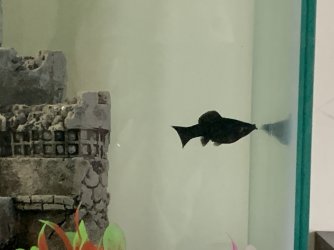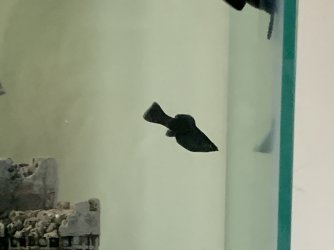It looks like she is pregnant but she also has something sticking out her butt, possibly threadworms (camallanus/ capillaria). Check her butt and see if there are any small thin red or white hair like things sticking out. If there is, the fish has thread/ round worms and will need to be treated (see below).
Female livebearers can carry up to 6 sperm packets from breeding with males and they use 1 sperm packet to fertilise each batch of eggs. The gestation period (from the time she fertilises the eggs to when she gives birth to free swimming babies) is about 1 month. After which she will fertilise another batch of eggs using another sperm packet. This allows female livebearers to produce young about once a month for up to 6 months without any males being present.
------------------------
You can use Praziquantel to treat the fish for gill flukes & tapeworms, and Levamisole to treat them for thread/ round worms. You treat them once a week for 3-4 weeks and do a 75% water change 24-48 hours after treating. Don't use the medications together because you can overdose the fish and kill them.
The easiest way to treat them is to use Praziquantel on day one. Do a 75% water change and gravel clean the substrate on day 2 & 3. Treat the tank with Levamisole on day 4 and do a 75% water change and gravel clean on day 5, 6 & 7 and then start with Praziquantel again on day 8.
The water changes will remove most of the medication so you don't overdose the fish. The gravel cleaning will suck out any worms and eggs that have been expelled by the fish. Repeating the treatment for 3 or 4 doses at weekly intervals will kill any worms that hatch from eggs.
------------------------
To work out the volume of water in the tank:
measure length x width x height in cm.
divide by 1000.
= volume in litres.
When you measure the height, measure from the top of the substrate to the top of the water level.
There is a calculator/ converter in the "How To Tips" at the top of this page that will let you convert litres to gallons if you need it.
Remove carbon from the filter before treating or it will adsorb the medication and stop it working.
Wipe the inside of the glass down with a clean fish sponge. Do a 75% water change and gravel clean the substrate. Make sure any new water is free of chlorine/ chloramine before it is added to the tank.
Clean the filter if it hasn't been done in the last 2 weeks. However, if the filter is less than 6 weeks old, do not clean it.
Increase surface turbulence/ aeration when using medications because they reduce the dissolved oxygen in the water.



